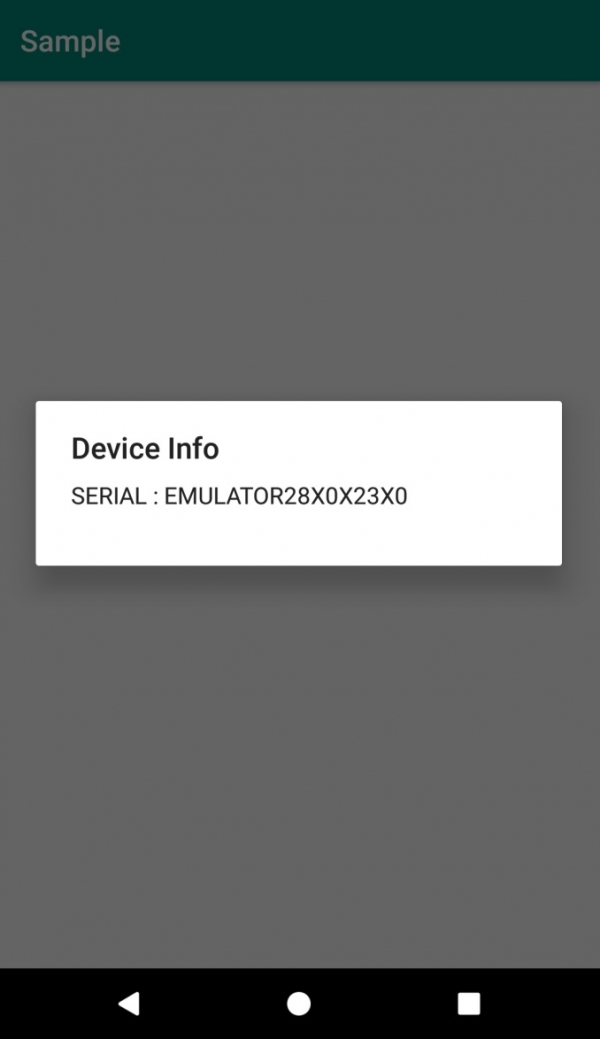
 Data Structure
Data Structure Networking
Networking RDBMS
RDBMS Operating System
Operating System Java
Java MS Excel
MS Excel iOS
iOS HTML
HTML CSS
CSS Android
Android Python
Python C Programming
C Programming C++
C++ C#
C# MongoDB
MongoDB MySQL
MySQL Javascript
Javascript PHP
PHP
- Selected Reading
- UPSC IAS Exams Notes
- Developer's Best Practices
- Questions and Answers
- Effective Resume Writing
- HR Interview Questions
- Computer Glossary
- Who is Who
How to find Serial number of Android device?
This example demonstrates how do I find serial number of android device.
Step 1 − Create a new project in Android Studio, go to File ⇒ New Project and fill all required details to create a new project.
Step 2 − Add the following code to res/layout/activity_main.xml.
<?xml version="1.0" encoding="utf-8"?> <RelativeLayout xmlns:android="http://schemas.android.com/apk/res/android" xmlns:tools="http://schemas.android.com/tools" android:layout_width="match_parent" android:layout_height="match_parent" tools:context=".MainActivity"> <TextView android:id="@+id/textView" android:layout_width="wrap_content" android:layout_height="wrap_content" android:layout_centerInParent="true" android:layout_below="@id/button" android:layout_marginTop="16sp"/> <Button android:id="@+id/button" android:layout_width="wrap_content" android:layout_height="wrap_content" android:onClick="showDeviceInfo" android:text="Get Serial Number" android:layout_centerInParent="true"/> </RelativeLayout>
Step 3 − Add the following code to src/MainActivity.java
import android.Manifest;
import android.app.AlertDialog;
import android.content.pm.PackageManager;
import android.support.v4.content.ContextCompat;
import android.os.Build;
import android.os.Bundle;
import android.support.v7.app.AppCompatActivity;
import android.telephony.TelephonyManager;
import android.view.View;
import android.widget.Toast;
public class MainActivity extends AppCompatActivity {
public static final int REQUEST_CODE_PHONE_STATE_READ = 100;
private int checkedPermission = PackageManager.PERMISSION_DENIED;
TelephonyManager manager;
@Override
protected void onCreate(Bundle savedInstanceState) {
super.onCreate(savedInstanceState);
setContentView(R.layout.activity_main);
checkedPermission = ContextCompat.checkSelfPermission(MainActivity.this,
Manifest.permission.READ_PHONE_STATE);
if (Build.VERSION.SDK_INT >= 23 && checkedPermission != PackageManager.PERMISSION_GRANTED) {
requestPermission();
} else
checkedPermission = PackageManager.PERMISSION_GRANTED;
}
private void requestPermission() {
Toast.makeText(MainActivity.this, "Requesting permission", Toast.LENGTH_SHORT).show();
this.requestPermissions(new String[]{Manifest.permission.READ_PHONE_STATE},
REQUEST_CODE_PHONE_STATE_READ);
}
public void showDeviceInfo(View v) {
manager = (TelephonyManager) getSystemService(this.TELEPHONY_SERVICE);
AlertDialog.Builder dBuilder = new AlertDialog.Builder(this);
StringBuilder stringBuilder = new StringBuilder();
if (checkedPermission != PackageManager.PERMISSION_DENIED) {
dBuilder.setTitle("Device Info");
stringBuilder.append("SERIAL : " + Build.SERIAL + "
");
} else {
dBuilder.setTitle("Permission denied");
stringBuilder.append("Can't access device info !");
}
dBuilder.setMessage(stringBuilder);
dBuilder.show();
}
@Override
public void onRequestPermissionsResult(int requestCode, String[] permissions, int[] grantResults) {
switch (requestCode) {
case REQUEST_CODE_PHONE_STATE_READ:
if (grantResults.length > 0 && grantResults[0]== PackageManager.PERMISSION_GRANTED ) {
checkedPermission = PackageManager.PERMISSION_GRANTED;
}
break;
}
}
}
Step 4 - Add the following code to androidManifest.xml
<?xml version="1.0" encoding="utf-8"?> <manifest xmlns:android="http://schemas.android.com/apk/res/android" package="app.com.sample"> <uses-permission android:name = "android.permission.INTERNET"/> <uses-permission android:name = "android.permission.READ_PHONE_STATE" /> <application android:allowBackup="true" android:icon="@mipmap/ic_launcher" android:label="@string/app_name" android:roundIcon="@mipmap/ic_launcher_round" android:supportsRtl="true" android:theme="@style/AppTheme"> <activity android:name=".MainActivity"> <intent-filter> <action android:name="android.intent.action.MAIN" /> <category android:name="android.intent.category.LAUNCHER" /> </intent-filter> </activity> </application> </manifest>
Let's try to run your application. I assume you have connected your actual Android Mobile device with your computer. To run the app from android studio, open one of your project's activity files and click Run ![]() icon from the toolbar. Select your mobile device as an option and then check your mobile device which will display your default screen –
icon from the toolbar. Select your mobile device as an option and then check your mobile device which will display your default screen –

Click here to download the project code.

